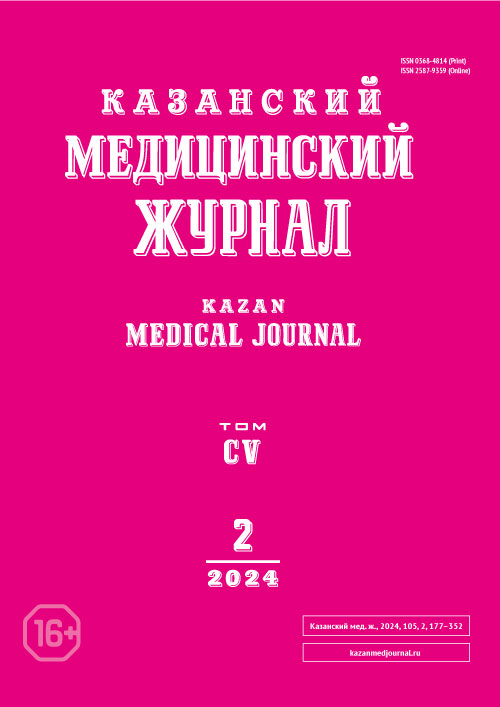Some features of intrauterine development of capillaries in the head and neck area
- Authors: Bychkova I.Y.1, Chekmareva I.A.2, Baranchugova L.M.3, Konorova I.L.4, Abduvosidov K.A.3,5
-
Affiliations:
- National Medical Research Center “Central Research Institute of Dentistry and Maxillofacial Surgery”
- National Medical Research Center for Surgery named after A.V. Vishnevsky
- Russian Biotechnological University (ROSBIOTECH)
- Moscow State Medical and Dental University named after A.I. Evdokimov
- Moscow Clinical Scientific and Practical Center named after A.S. Loginov
- Issue: Vol 105, No 2 (2024)
- Pages: 222-230
- Section: Theoretical and clinical medicine
- Submitted: 29.08.2023
- Accepted: 25.01.2024
- Published: 01.04.2024
- URL: https://kazanmedjournal.ru/kazanmedj/article/view/568905
- DOI: https://doi.org/10.17816/KMJ568905
- ID: 568905
Cite item
Abstract
BACKROUND: The development of capillaries in human embryogenesis is a multi-stage process influenced by genetic factors and signaling pathways, which is of interest in studying the mechanisms of vascular bed formation in the prenatal period of human development.
AIM: To study the development of capillaries in the embryonic and early fetal periods and determine the morphological prerequisites leading to the formation of developmental defects.
MATERIAL AND METHODS: The biomaterial of 50 embryos and fetuses from 4 to 12 weeks was studied. A histological and electron microscopic examination of the specimens was performed in the axial plane at the level of both jaws and neck. The volume fraction of capillaries and muscle fibers in the structure of the sternocleidomastoid muscle was determined. Data on the volume fraction of each component were presented as median and interquartile range. Quantitative analysis was performed using the Kruskal–Wallis and Mann–Whitney methods with Bonferroni correction.
RESULTS: At the 4th week, a capillary network began to develop from the mesenchyme, which took on a complete form by the 8th–10th week. The proportion of capillaries increased from the 6th to the 10th week, and by the 12th week it decreased. A statistically significant pattern of changes in the ratio of the proportion of capillaries in muscles with the volume fraction of muscle fibers itself was revealed. As the mass of the muscle fibers themselves increased, the proportion of capillaries in it decreased significantly from 1.92 (1.77; 2)% at 4–6 weeks of embryogenesis to 0.25 (0.23; 0.26)% at 10–12 weeks.
CONCLUSION: The critical period for the development of capillaries is the intrauterine period from the 4th to the 12th week of development, when in the structure of muscles as an organ, the vascular component first prevails over the muscular component itself, and then sharply decreases.
Full Text
About the authors
Irina Yu. Bychkova
National Medical Research Center “Central Research Institute of Dentistry and Maxillofacial Surgery”
Author for correspondence.
Email: mana93@list.ru
ORCID iD: 0000-0003-0728-9831
M.D., Cand. Sci. (Med.)
Russian Federation, MoscowIrina A. Chekmareva
National Medical Research Center for Surgery named after A.V. Vishnevsky
Email: chia236@mail.ru
ORCID iD: 0000-0003-0126-4473
D. Sci. (Biol.), Head, Lab. of Electron Microscopy
Russian Federation, MoscowLarisa M. Baranchugova
Russian Biotechnological University (ROSBIOTECH)
Email: lar.baranch@gmail.com
ORCID iD: 0000-0002-3252-4429
M.D., Cand. Sci. (Med.), Assoc. Prof., Depart. of Human Morphology
Russian Federation, MoscowIrina L. Konorova
Moscow State Medical and Dental University named after A.I. Evdokimov
Email: konorova.irina@yandex.ru
ORCID iD: 0009-0006-7125-9759
D. Sci. (Biol.), Prof., Depart. of Histology, Embryology and Cytology
Russian Federation, MoscowKhurshed A. Abduvosidov
Russian Biotechnological University (ROSBIOTECH); Moscow Clinical Scientific and Practical Center named after A.S. Loginov
Email: sogdiana99@gmail.com
ORCID iD: 0000-0002-5655-338X
M.D., D. Sci. (Med.), Assoc. Prof., Head of Depart., Depart. of Human Morphology; Ultrasound Diagnostics Doctor
Russian Federation, Moscow; MoscowReferences
- Bychkova IYu, Abduvosidov KA, Roginskiy VV. The role of hypoxia in the pathogenesis of congenital hyperplasia of blood vessels in the head and neck in children (literature review). Acta Biomedica Scientifica. 2022;7(1):37–47. (In Russ.) doi: 10.29413/ABS.2022-7.1.5.
- Roginskiy VV, Nadtochiy AG, Grigoryan AS, Sokolov YuYu, Soldatskiy YuL, Nerobeev AI, Kotlukova NP, Babichenko II, Bliznyukov OP. Atlas patologii sosudov golovy i shei. (Atlas of vascular pathology of the head and neck.) Roginskiy VV, editor. M.: Liberi plyus; 2021. 448 p. (In Russ.)
- Culver JC, Dickinson ME. The effects of hemodynamic force on embryonic development. Microcirculation. 2010;17(3):164–178. doi: 10.1111/j.1549-8719.2010.00025.x.
- Yu Y, Flint AF, Mulliken JB, Wu JK, Bischoff J. Endothelial progenitor cells in infantile hemangioma. Blood. 2004;103(4):1373–1375. doi: 10.1182/blood-2003-08-2859.
- Petrenko VM. Osnovy embriologii. Voprosy razvitiya v anatomii cheloveka. (Fundamentals of embryology. Developmental issues in human anatomy.) SPb.: DEAN; 2003. 400 p. (In Russ.)
- Eichmann A, Yuan L, Moyon D, Lenoble F, Pardanaud L, Breant C. Vascular development: From precursor cells to branched arterial and venous networks. Int J Dev Biol. 2005;49(2–3):259–267. doi: 10.1387/ijdb.041941ae.
- Lugin IA. Features of intertissue interactions in the processes of morphogenesis of organs with a heterogeneous origin of tissue components. Mir meditsiny i biologii. 2012;4. https://cyberleninka.ru/article/n/osobennosti-mezhtkanevyh-vzaimodeystviy-v-protsessah-morfogeneza-organov-s-geterogennym-proishozhdeniem-tkanevyh-komponentov (access date: 02.08.2023) (In Russ.)
- Reva IV, Garmash AI, Sadovaya YAO, Shindina AD, Indyk MV, Kalinin IO, Shek LI, Furgal AA, Sorokin VA, Reva GV. The vessels development characteristics in the human embryon. Mezhdunarodnyy zhurnal prikladnykh i fundamentalnykh issledovaniy. 2018;(3):189–198. (In Russ.) doi: 10.17513/mjpfi.12173.
- Roman BL, Pekkan K. Mechanotransduction in embryonic vascular development. Biomech Model Mechanobiol. 2012;11(8):1149–1168. doi: 10.1007/s10237-012-0412-9.
- Tozer S, Bonnin MA, Relaix F, Di Savino S, García-Villalba P, Coumailleau P, Duprez D. Involvement of vessels and PDGFB in muscle splitting during chick limb development. Development. 2007;134(14):2579–2591. doi: 10.1242/dev.02867.
- Kolonin KV. Biochemistry of angiogenesis in normal and pathological conditions. In: Nauka i obrazovanie: otechestvennyy i zarubezhnyy opyt. (Science and education: domestic and foreign experience.) Belgorod: OOO GiK; 2019. р. 263–281. (In Russ.)
- Tybinka AM. Structure and development of vessels in the intestinal mesentery. Naukovij vіsnik Lvіvskogo nacіonalnogo unіversitetu veterinarnoї medicini ta bіotekhnologіj іmenі SZ Ґzhickogo. 2017;78(19):62–67 (In Russ.) doi: 10.15421/nvlvet7813.
- Natsional'noe rukovodstvo. Chelyustno-litsevaya khirurgiya. (National manual. Maxillofacial Surgery.) AA Kulakov, editor. M.: GEOTAR-Media; 2019. 696 p. (In Russ.)
- Gupta A. Histopathology of vascular anomalies. Clin Plast Surg. 2011;1(38):31–44. doi: 10.1016/j.cps.2010.08.007.
- Mulliken J, Burrows PE, Fishman SJ. Vascular Anomalies Hemangiomas and Malformations. 2th ed. N.Y.: Oxford University Press; 2013. 1095 p.
Supplementary files










